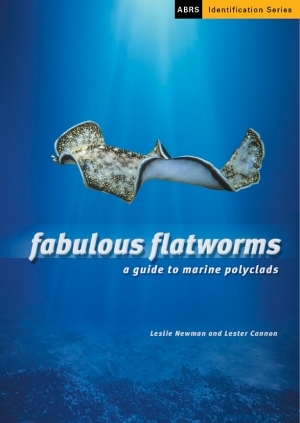
Fabulous Flatworms: a guide to marine polyclads
Leslie Newman & Lester Cannon
CD ROM
Australian Biological Resources Study/CSIRO Publishing,
Published: 2005
ISBN 0 643 06964 X
Price: AU $75.00
There are very few nudibranch experts or enthusiasts who have not been fooled by a spectacularly coloured marine flatworm. In quite a remarkable evolutionary convergence these two quite unrelated animal groups have evolved bright colour patterns and similar chemical defence strategies. Even more remarkable, are the many occasions a species of flatworm and a species of nudibranch have evolved almost identical colour patterns. In many ways, both groups of animals also present similar problems for the experts in identifying species. Both groups are soft-bodied with few hard parts, so descriptive anatomy, by necessity, needs information on the shape and colour of the living animal, which are both lost on preservation. The great advances in colour photography over recent years have been of immense value in building our knowledge of species diversity in boith these groups.
This CD Rom is best reviewed in conjunction with the book Marine Flatworms. The World of Polyclads by the same authors, as the general content, on the biology and natural history of these fascinating animals is the same. My review of the contents of that book apply also to this CD.
Where the CD differs is that it includes an interactive identification key to about 400 species based on the colour patterns and general shape. It also differs in the quantity of colour photographs - over 1200 on the CD compared to about 350 in the book, which allows multiple photos showing colour variation within a species. From these sort of comparisons, you might be wondering why anyone would want the book at all. My feeling is that they complement each other rather than replace each other. What I liked about the book when it first appeared was its large format and large, often spectacular photographs - and like all books I get pleasure in being able to flick through the pages looking for a particular photo or pattern. In the CD on the other hand, the photos are relatively small, but there are many more of them. If you just want to read about flatworm biology and natural history then the book's my preferred mode, but for identifying an individual species, the CD wins. So I guess my advice is to buy both.
Both book and CD are available at all the usual sources, but I have just noticed that CSIRO Publishing have a special combined book & CD deal, but it is possible other sellers do as well.
Authorship detailsRudman, W.B., 2007 (January 2) Fabulous Flatworms: a guide to marine polyclads. Leslie Newman & Lester Cannon. [In] Sea Slug Forum. Australian Museum, Sydney. Available from http://www.seaslugforum.net/factsheet/brnewman2
